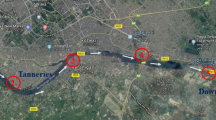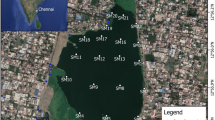Abstract
Aquatic pollution pose a serious challenge to the scientific community worldwide, since lakes or reservoirs find multifarious use and most often their water is used for drinking, bathing, irrigation, and aquaculture. Nine metals and several physicochemical parameters, from four sampling sites in a tropical lake receiving the discharges from a thermal power plant, a coal mine, and a chlor-alkali industry, were studied from 2004 to 2005. Pertaining to metal pollution, the site most polluted with heavy metals was Belwadah, i.e., waters and sediments had the highest concentration of all the metals examined. The reference site was characterized by the presence of low concentrations of metals in waters and sediments. Following the water quality monitoring, 2-month field phytoremediation experiments were conducted using large enclosures at the discharge point of different polluted sites of the lake. During field phytoremediation experiments using aquatic macrophytes, marked percentage reduction in metals concentrations were recorded. The percentage decrease for different metals was in the range of 25% to 67.90% at Belwadah (with Eichhornia crassipes and Lemna minor), 25% to 77.14% at Dongia nala (with E. crassipes, L. minor and Azolla pinnata), and 25% to 71.42% at Ash pond site of G.B. Pant Sagar (with L. minor and A. pinnata). Preliminary studies of polluted sites are useful for improved microcosm design and for the systematic extrapolation of information from experimental ecosystems to natural ecosystems.
Similar content being viewed by others
References
Ali, M. B., Tripathi, R. D., Rai, U. N., Pal, A., & Singh, S. P. (1999). Physico-chemical characteristics and pollution level of Lake Nainital (U.P., India): Role of macrophytes and phytoplankton in biomonitoring and phytoremediation of toxic metal ions. Chemosphere, 39(12), 2171–2182.
APHA (2000). Standard methods for the examination of water and wastewater (10th ed.). Washington, DC: American Public Health Association.
Cardwell, A. J., Hawker, D. W., & Greenway, M. (2002). Metal accumulation in aquatic macrophytes from south east Queensland, Australia. Chemosphere, 48, 653–663.
Cymerman, A. S., & Kempers, A. J. (2001). Concentration of heavy metals and plant nutrients in water, sediments and aquatic macrophytes of anthropogenic lakes (former open cut brown coal mines) differing in stage of acidification. Science of the Total Environment, 281, 87–98.
Deng, H., Ye, Z. H., & Wong, M. H. (2004). Accumulation of lead, zinc, copper and cadmium by 12 wetland plant species thriving in metal contaminated sites in China. Environmental Pollution, 132, 29–40.
Linnik, P. M., & Zubenko, I. B. (2000). Role of bottom sediments in the secondary pollution of aquatic environments by heavy-metal compounds. Lakes and Reservoirs: Research and Management, 5, 11–21.
Linnik, P. N., Zhuravleva, L. A., Samoilenko, V. N., & Yu, N. B. (1993). Influence of exploitation regime on quality of water in the Dnieper reservoirs and mouth zone of the Dnieper River. Gidrobiologicheskiy Zhurnal, 29(1), 86–99 (in Russian).
Mireles, A., Solis, C., Andrade, E., Lagunas-Solar, M., Pina, C., & Flocchini, R. G. (2004). Heavy metal accumulation in plants and soil irrigated with wastewater from Mexico City. Nuclear Instruments & Methods in Physics Research. Section B, Beam Interactions with Materials and Atoms, 1(219–220), 187–190. doi:10.1016/j.nimb.2004.01.051.
Morillo, J., Usero, J., & Gracia, I. (2002). Partitioning of metals in sediments from the Odiel River (Spain). Environmental Interpretation, 28, 263–271.
Murozono, K., Ishii, K., Yamazaki, H., Matsuyama, S., & Iwasaki, S. (1999). PIXE spectrum analysis taking into account bremsstrahlung spectra. Nuclear Instruments & Methods in Physics Research. Section B, Beam Interactions with Materials and Atoms, 150, 76–82.
Qiu, D., Wu, Z., Liu, B., Deng, J., Fu, G., & He, F. (2001). The restoration of aquatic macrophytes for improving water quality in a hypertrophic shallow lake in Hubei Province, China. Ecological Engineering, 18, 147–156.
Rai, P. K. (2007a). Wastewater management through biomass of Azolla pinnata: An eco-sustainable approach. Ambio, 36(5), 426–428.
Rai, P. K. (2007b). Phytoremediation of Pb and Ni from industrial effluents using Lemna minor: An eco-sustainable approach. Bulletin of Bioscience, 5(1), 67–73.
Rai, P. K. (2008a). Heavy-metal pollution in aquatic ecosystems and its phytoremediation using wetland plants: An eco-sustainable approach. International Journal of Phytoremediation, 10(2), 133–160.
Rai, P. K. (2008b). Phytoremediation of Hg and Cd from industrial effluents using an aquatic free floating macrophyte Azolla pinnata. International Journal of Phytoremediation, 10(5), 430–439.
Rai, P. K. (2008c). Heavy metal phytoremediation from aquatic ecosystems with special reference to macrophytes. Critical Reviews in Environmental Science and Technology (in press).
Rai, P. K. (2008d). Mercury pollution from chlor-alkali industry in a tropical lake and its bio-magnification in aquatic biota: Link between chemical pollution, biomarkers and human health concern. Human and Ecological Risk Assessment: An International Journal, 14(6), 1318–1329.
Rai, P. K., & Tripathi, B. D. (2006). Impact of thermal power effluent on aquatic environment. National Journal of Radiation Research, 3(4), 190–192.
Rai, P. K., & Tripathi, B. D. (2007a). Microbial contamination in vegetables due to irrigation with partially treated municipal wastewater in a tropical city. International Journal of Environmental Health Research, 17(5), 389–395.
Rai, P. K., & Tripathi, B. D. (2007b). Heavy metals removal using nuisance blue green alga Microcystis in continuous culture experiment. Environmental Science, 4(1), 53–59.
Rai, P. K., & Tripathi, B. D. (2008). Heavy metals in industrial wastewater, soil and vegetables in Lohta village, India. Toxicology and Environmental Chemistry, 90(2), 247–257.
Rai, P. K., & Tripathi, B. D. (2009). Comparative assessment of Azolla pinnata and Vallisneria spiralis in Hg removal from G.B. Pant Sagar of Singrauli Industrial region, India. Environmental Monitoring and Assessment, 148, 75–84.
Rai, U. N., Sinha, S., Tripathi, P., & Chandra, P. (1995). Wastewater treatability potential of some aquatic macrophytes: Removal of heavy metals. Ecological Engineering, 5, 5–12.
Rai, P. K., Sharma, A. P., & Tripathi, B. D. (2007). Urban environment status in Singrauli Industrial region and its eco-sustainable management: A case study on heavy metal pollution. In L. Vyas (Ed.), Urban planing and environment, strategies and challenges (pp. 213–217). London: McMillan.
Sagrario, M. A. G., Jeppesen, E., Goma, J., Sondergaard, M., Jensen, J. P., Lauridsen, T., et al. (2005). Does high nitrogen loading prevent clear-water conditions in shallow lakes at moderately high phosphorus concentrations? Freshwater Biology, 50, 27–41.
Snow, A. M., & Ghaly, A. E. (2008). Assessment of hydroponically grown macrophytes for their suitability as fish feed. American Journal of Biochemistry and Biotechnology, 4(1), 43–56.
Viaroli, P., Bartoli, M., Fumagalli, I., & Giordani, G. (1997). Relationship between benthic fluxes and macrophyte cover in a shallow brackish lagoon. Water, Air and Soil Pollution, 99, 533–540.
Author information
Authors and Affiliations
Corresponding author
Rights and permissions
About this article
Cite this article
Rai, P.K. Phytoremediation of heavy metals in a tropical impoundment of industrial region. Environ Monit Assess 165, 529–537 (2010). https://doi.org/10.1007/s10661-009-0964-z
Received:
Accepted:
Published:
Issue Date:
DOI: https://doi.org/10.1007/s10661-009-0964-z




